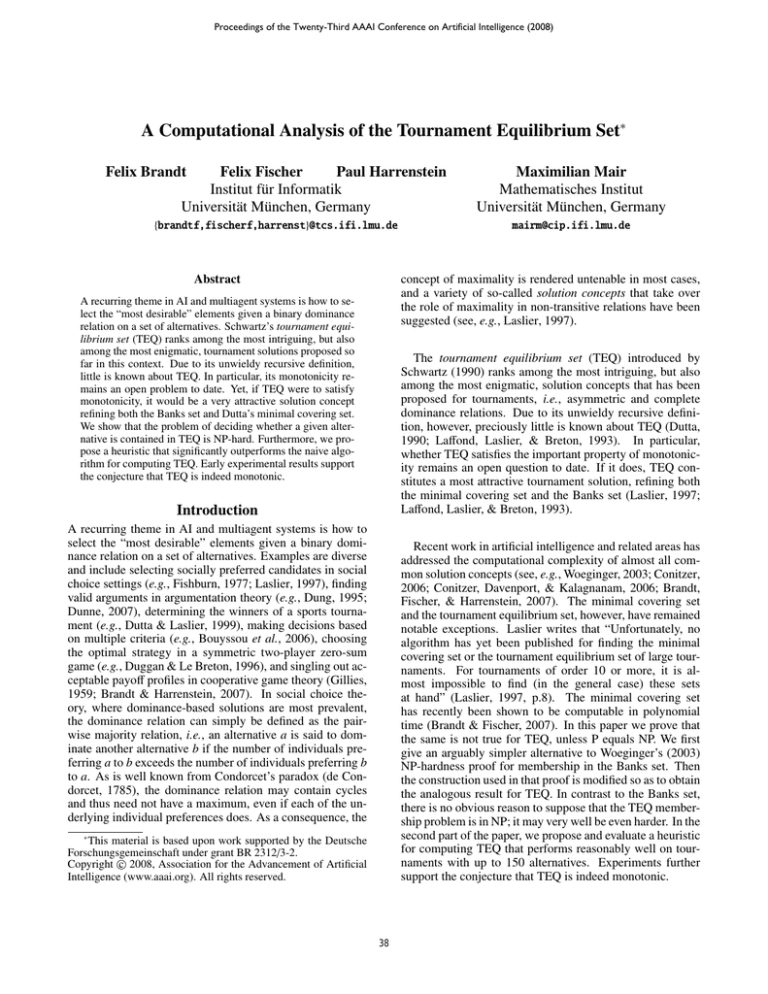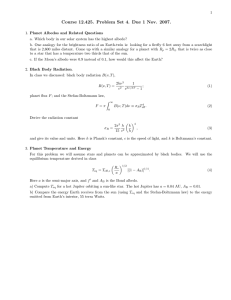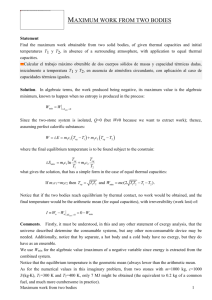A Computational Analysis of the Tournament Equilibrium Set
advertisement

Proceedings of the Twenty-Third AAAI Conference on Artificial Intelligence (2008)
A Computational Analysis of the Tournament Equilibrium Set∗
Felix Brandt
Felix Fischer
Paul Harrenstein
Institut für Informatik
Universität München, Germany
{brandtf,fischerf,harrenst}@tcs.ifi.lmu.de
Abstract
Maximilian Mair
Mathematisches Institut
Universität München, Germany
mairm@cip.ifi.lmu.de
concept of maximality is rendered untenable in most cases,
and a variety of so-called solution concepts that take over
the role of maximality in non-transitive relations have been
suggested (see, e.g., Laslier, 1997).
A recurring theme in AI and multiagent systems is how to select the “most desirable” elements given a binary dominance
relation on a set of alternatives. Schwartz’s tournament equilibrium set (TEQ) ranks among the most intriguing, but also
among the most enigmatic, tournament solutions proposed so
far in this context. Due to its unwieldy recursive definition,
little is known about TEQ. In particular, its monotonicity remains an open problem to date. Yet, if TEQ were to satisfy
monotonicity, it would be a very attractive solution concept
refining both the Banks set and Dutta’s minimal covering set.
We show that the problem of deciding whether a given alternative is contained in TEQ is NP-hard. Furthermore, we propose a heuristic that significantly outperforms the naive algorithm for computing TEQ. Early experimental results support
the conjecture that TEQ is indeed monotonic.
The tournament equilibrium set (TEQ) introduced by
Schwartz (1990) ranks among the most intriguing, but also
among the most enigmatic, solution concepts that has been
proposed for tournaments, i.e., asymmetric and complete
dominance relations. Due to its unwieldy recursive definition, however, preciously little is known about TEQ (Dutta,
1990; Laffond, Laslier, & Breton, 1993). In particular,
whether TEQ satisfies the important property of monotonicity remains an open question to date. If it does, TEQ constitutes a most attractive tournament solution, refining both
the minimal covering set and the Banks set (Laslier, 1997;
Laffond, Laslier, & Breton, 1993).
Introduction
A recurring theme in AI and multiagent systems is how to
select the “most desirable” elements given a binary dominance relation on a set of alternatives. Examples are diverse
and include selecting socially preferred candidates in social
choice settings (e.g., Fishburn, 1977; Laslier, 1997), finding
valid arguments in argumentation theory (e.g., Dung, 1995;
Dunne, 2007), determining the winners of a sports tournament (e.g., Dutta & Laslier, 1999), making decisions based
on multiple criteria (e.g., Bouyssou et al., 2006), choosing
the optimal strategy in a symmetric two-player zero-sum
game (e.g., Duggan & Le Breton, 1996), and singling out acceptable payoff profiles in cooperative game theory (Gillies,
1959; Brandt & Harrenstein, 2007). In social choice theory, where dominance-based solutions are most prevalent,
the dominance relation can simply be defined as the pairwise majority relation, i.e., an alternative a is said to dominate another alternative b if the number of individuals preferring a to b exceeds the number of individuals preferring b
to a. As is well known from Condorcet’s paradox (de Condorcet, 1785), the dominance relation may contain cycles
and thus need not have a maximum, even if each of the underlying individual preferences does. As a consequence, the
Recent work in artificial intelligence and related areas has
addressed the computational complexity of almost all common solution concepts (see, e.g., Woeginger, 2003; Conitzer,
2006; Conitzer, Davenport, & Kalagnanam, 2006; Brandt,
Fischer, & Harrenstein, 2007). The minimal covering set
and the tournament equilibrium set, however, have remained
notable exceptions. Laslier writes that “Unfortunately, no
algorithm has yet been published for finding the minimal
covering set or the tournament equilibrium set of large tournaments. For tournaments of order 10 or more, it is almost impossible to find (in the general case) these sets
at hand” (Laslier, 1997, p.8). The minimal covering set
has recently been shown to be computable in polynomial
time (Brandt & Fischer, 2007). In this paper we prove that
the same is not true for TEQ, unless P equals NP. We first
give an arguably simpler alternative to Woeginger’s (2003)
NP-hardness proof for membership in the Banks set. Then
the construction used in that proof is modified so as to obtain
the analogous result for TEQ. In contrast to the Banks set,
there is no obvious reason to suppose that the TEQ membership problem is in NP; it may very well be even harder. In the
second part of the paper, we propose and evaluate a heuristic
for computing TEQ that performs reasonably well on tournaments with up to 150 alternatives. Experiments further
support the conjecture that TEQ is indeed monotonic.
∗
This material is based upon work supported by the Deutsche
Forschungsgemeinschaft under grant BR 2312/3-2.
c 2008, Association for the Advancement of Artificial
Copyright Intelligence (www.aaai.org). All rights reserved.
38
Preliminaries
a
A tournament T is a pair (A, ), where A is a finite set of
alternatives and an irreflexive, anti-symmetric, and complete binary relation on A, also referred to as the dominance
relation. Intuitively, a b signifies that alternative a beats
b in a pairwise comparison. We write T for the class of
all tournaments and have T (A) denote the set of all tournaments on a fixed set A of alternatives. If T is a tournament on A, then every subset X of A induces a tournament
T |X = (X, |X ), where |X = {(x, y) ∈ X × X : x y}.
As the dominance relation is not assumed to be transitive in general, there need not be a so-called Condorcet winner, i.e., an alternative that dominates all other alternatives.
A tournament solution S is defined as a function that associates with each tournament T on A a subset S (T ) of A.
The definition of a tournament solution commonly includes
the requirement that S (T ) be non-empty if T is defined on a
non-empty set of alternatives and that it select the Condorcet
winner if there is one (Laslier, 1997, p.37). For X a subset
of A, we also write S (X) for the more cumbersome S (T |X ),
provided that the tournament T is known from the context. A
tournament solution S is said to be monotonic if for any two
tournaments T, T 0 ∈ T (A) which only differ in that b a in
T and a b in T 0 , a ∈ S (T ) implies that also a ∈ S (T 0 ),
i.e., reinforcing an alternative cannot cause it to be excluded
from the solution set. Monotonicity is a vital property that
all reasonable tournament solutions satisfy. In this paper,
we will be concerned with two particular tournament solutions, the Banks set and Schwartz’s tournament equilibrium
set (TEQ). For a proper formal definition, however, we need
some auxiliary notions and notations.
Let R be a binary relation on a set A. We write R∗ for the
transitive reflexive closure of R. By the top cycle TC A (R)
we understand the maximal elements of the asymmetric part
of R∗ . A subset X of A is said to be transitive if R is transitive
on X. For X ⊆ Y ⊆ A, X is called maximal transitive in Y if
X is transitive and no proper superset of X in Y is. Clearly,
every transitive set is contained in a maximal transitive set.
Given a set Z = {Zi }i∈I of pairwise disjoint subsets of A, a
subset X of A will be called a choice set for Z if it contains
precisely one element from each subset Zi ∈ Z.
In tournaments, maximal transitive sets are also referred
to as Banks trajectories. The Banks set BA(T ) of a tournament T then collects the maximal elements of the Banks
trajectories.
b
c
d
e
Figure 1: Example due to Schwartz, 1990, where BA(T ) =
{a, b, c, d} and TEQ(T ) = {a, b, c}. The TEQ relation → is
indicated by thick edges.
X = A. Thus, for each alternative a one examines the
set D(a) of its dominators, and solves the subtournament
T |D(a) by means of the solution S . In the subrelation a is
then only dominated by the alternatives in S (D(a)). This of
course, still leaves open the question as to the choice of the
solution concept S . Now, in the case of TEQ, S is taken
to be TEQ itself! This recursion is well-defined because for
any X ⊆ A and a ∈ X, the set DX (a) is a proper subset of X.
Thus, in order to determine the TEQ relation in a subtournament T , one has to calculate the TEQ of smaller and smaller
subtournaments of T .
Definition 2 (Tournament equilibrium set) Let
T ∈ T (A). For each subset X ⊆ A, define the tournament equilibrium set TEQ(X) for X as
TEQ(X) = TC X (→X ),
where →X is defined as the binary relation on X such that
for all x, y ∈ X,
x →X y if and only if x ∈ TEQ(DX (y)).
Observe that the TEQ relation →X is a subset of the dominance relation and that, if DX (x) , ∅, then there is some
y ∈ DX (x) with y →X x. Furthermore, Definition 2 directly
yields a recursive algorithm to compute TEQ. Some reflection reveals that this naive algorithm requires time exponential in |A| in the worst case.
It can easily be established that the Banks set and TEQ
both select the Condorcet winner of a tournament if there
is one. Moreover, in a cyclic tournament on three alternatives, the Banks set and TEQ both consist of all alternatives.
In more complex tournaments, however, the Banks set and
TEQ may differ. Consider, for example, the tournament T
depicted in Figure 1. We first calculate the TEQ relation →.
Thus, e.g., for alternative e we find D(e) = {a, c, d}, which
constitutes a three-cycle, and so TEQ(D(e)) = {a, c, d}. Accordingly, a → e, c → e, as well as d → e. Doing this
for all alternatives, we find TEQ(T ) = {a, b, c} as the top
cycle TC(→) of the relation →. By contrast, the Banks set
consists of the four elements a, b, c and d. E.g., d ∈ BA(T ),
because {d, c, e} is a maximal transitive set with maximal element d. Nevertheless, TEQ is always included in the Banks
set.
Definition 1 (Banks set) Let T be a tournament on A. An
alternative a ∈ A is in the Banks set BA(T ) of T if a is a
maximal element of some maximal transitive set in T .
The tournament equilibrium set TEQ(T ) of a tournament T on A is defined as the top cycle of a particular subrelation of the dominance relation, referred to as the TEQ relation in the following. The underlying idea is that an alternative is only “properly” dominated, i.e., dominated according
to the subrelation, if it is dominated by an element that is selected by some tournament solution concept S . To make this
idea precise, for X ⊆ A, we write DX (a) = { b ∈ X : b a }
for the dominators of a in X, omitting the subscript when
39
Proposition 1 (Schwartz, 1990) Let T = (A, ) be a tournament. Then, TEQ(T ) ⊆ BA(T ).
c5
c4
c3
Otherwise, little is known and much surmised about
the theoretical properties of TEQ. For example, Schwartz
(1990) conjectured that the top cycle of the TEQ relation
is always weakly connected, a property of TEQ we will refer to as CTC for connected top cycle. Laffond, Laslier, &
Breton (1993) showed that TEQ satisfying CTC is equivalent to it having a number of useful properties. In particular, TEQ is monotonic if and only if CTC holds. Moreover,
CTC implies the inclusion of TEQ in the minimal covering
set (see, e.g., Laslier, 1997), another appealing tournament
solution. Thus, if TEQ satisfies CTC it might be considered a very strong solution concept. Otherwise, TEQ lacks
the vital property of monotonicity and as such it would be
severely flawed as a tournament solution.
c2
c1
d
q
p
s
r
p
q
¬r
y2
Figure 2: Tournament T ϕBA for the 3-CNF formula ϕ = (¬p∨
s ∨ q) ∧ (p ∨ s ∨ r) ∧ (p ∨ q ∨ ¬r). Omitted edges are assumed
to point downwards.
We begin our investigation of the computational complexity of the TEQ membership problem by giving an alternative proof for NP-hardness of the analogous problem for the
Banks set. The latter was first demonstrated by Woeginger
(2003) using a reduction from graph three-colorability. Our
proof works by a reduction from 3SAT, the NP-complete
satisfiability problem for Boolean formulas in conjunctive
normal form with exactly three literals per clause (see, e.g.,
Papadimitriou, 1994). It is arguably simpler than Woeginger’s, and a much similar construction will be used in the
next section to prove NP-hardness of membership in TEQ.
The tournaments used in both reductions will be taken from
a special class T ∗ .
3
2
1
),
∨ xm
∨ xm
form (3CNF), i.e., ϕ = (x11 ∨ x12 ∨ x13 ) ∧ · · · ∧ (xm
1 2 3
where each x ∈ {xi , xi , xi : 1 ≤ i ≤ m} is a literal. For each
clause xi1 ∨ xi2 ∨ xi3 we assume xi1 , xi2 and xi3 to be distinct
literals. We moreover assume the literals to be indexed and
by Xi we denote the set {xi1 , xi2 , xi3 }. For literals x we have
x̄ = ¬p if x = p, and x̄ = p if x = ¬p, where p is some
propositional variable. We may also assume that if x and y
are literals in the same clause, then x , ȳ. We say a 3CNF
1
2
3
ϕ = (x11 ∨ x12 ∨ x13 ) ∧ · · · ∧ (xm
∨ xm
∨ xm
) is satisfiable if
there is a choice set V for {Xi }1≤i≤m such that v0 = v̄ for
no v, v0 ∈ V. Next we define for each 3SAT formula ϕ the
tournament T ϕBA .
Definition 3 (The class T ∗ ) A tournament (A, ) is in the
class T ∗ if it satisfies the following properties. There is some
odd integer n ≥ 1, the number of layers in the tournament,
such that A = C ∪ U1 ∪ · · · ∪ Un , where C, U1 , . . . , Un are
pairwise disjoint and C = {c0 , . . . , cn }. Each Ui is a singleton if i is even, and Ui = {u1i , u2i , u3i } if i is odd. The complete
and asymmetric dominance relation is such that for all
ci ∈ Ci , c j ∈ C j , ui ∈ Ui , u j ∈ U j (0 ≤ i, j ≤ n):
ci c j ,
ui c j ,
c j ui ,
ui u j ,
uki uli ,
s
y1
An Alternative NP-Hardness Proof for
Membership in the Banks Set
(i)
(ii)
(iii)
(iv)
(v)
¬p
Definition 4 (Banks construction) Let ϕ be a 3CNF (x11 ∨
1
2
3
∨ xm
∨ xm
). Define T ϕBA = (C ∪ U, ) as
x12 ∨ x13 ) ∧ · · · ∧ (xm
∗
the tournament in the class T with 2m − 1 layers such that
for all 1 ≤ j < 2m,
(
Xi
if j = 2i − 1,
Uj =
{yi } if j = 2i
if i > j,
if i = j,
if i , j,
if i < j and at least one of i and j is even,
if i is odd and k ≡ l − 1 (mod 3)
and such that for all x ∈ Xi and x0 ∈ X j (1 ≤ i, j ≤ m),
x x0
if both j < i and x0 = x̄ or both i < j and x0 , x̄.
Observe that in conjunction with the other requirements on
the dominance relation of a tournament in T ∗ , this completely fixes the dominance relation of T ϕBA .
S We also refer to c0 by d, for “decision node” and to
1≤i≤n U n by U. For i = 2k, we have
S as a notational convention Ui = Yk = {yk } and set Y = 1≤2k≤n Yk .
An example of a tournament T ϕBA for a 3CNF ϕ is shown in
Figure 2. We are now in a position to present our alternative
proof that the Banks membership problem is NP-complete.
Observe that this definition fixes the dominance relation between any two alternatives except for some pairs of alternatives that are both in U.
As a next step in the argument, we associate with each
instance of 3SAT a tournament in the class T ∗ . An instance
of 3SAT is given by a formula ϕ in 3-conjunctive normal
Theorem 1 The problem of deciding whether a particular alternative is in the Banks set of a tournament is NPcomplete.
40
Proof: Membership in NP is obvious. For a fixed alternative d, we can simply guess a transitive subset of alternatives V with d as maximal element and verify that V is also
maximal with respect to set inclusion.
For NP-hardness, we show that T ϕBA contains a maximal
transitive set with maximal element d if and only if ϕ is satisfiable. First observe that V is a maximal transitive subset
with maximal element d in T ϕBA only if both
(i) for all 1 ≤ i < 2m there is a u ∈ Ui such that u ∈ V, and
(ii) there are no 1 ≤ i < j < 2m, u ∈ Ui , u0 ∈ U j with
u, u0 ∈ V such that u j ui .
Regarding (i), if there is an 1 ≤ i < 2m such that no element
of Ui is contained in V, we can always add ci to V in order to
obtain a larger transitive set. If (ii) were not to hold, both i
and j have to be odd for u j to dominate ui . However, in light
of (i), there has to be k with i < k < j and u00 ∈ Uk such
that u00 ∈ V. It follows that V is not transitive because u, u00 ,
and u0 form a cycle. If there is maximal transitive set V
with maximal element d complying with both (i) and (ii),
a satisfying assignment of ϕ can be obtained by letting all
literals contained in X ∩ V be true.
For the opposite direction, assume that ϕ is satisfiable.
Then there is a choice set W for {Xi }1≤i≤m such that x0 =
x̄ for no x, x0 ∈ W. Obviously V = W ∪ {y1 , . . . , ym−1 } ∪
{d} does not contain any cycles and thus is transitive with
maximal element d. In order to obtain a larger transitive set
with a different maximal element, we need to add ci for some
1 ≤ i ≤ m to V. However, V ∪ {ci } always contains a cycle
consisting of ci , d, and u for some u ∈ Ui , contradicting
the transitivity of V ∪ {ci }. We have thus shown that d is
the maximal element of some maximal transitive set in T ϕBA
containing V as a subset.
c9
c8
c7
c6
c5
c4
c3
c2
c1
d
z11
z21
z31
p
s
r
z12
z22
z32
p
q
¬r
y3
y4
Figure 3: Tournament T ϕTEQ for the 3-CNF formula ϕ =
(¬p ∨ s ∨ q) ∧ (p ∨ s ∨ r) ∧ (p ∨ q ∨ ¬r).
An example for such a tournament is shown in Figure 3.
We now proceed to show that a 3SAT formula ϕ is satisfiable if and only if the decision node d is in the tournament equilibrium set of T ϕTEQ . We make use of the following
lemma.
Lemma 1 Let T = (C ∪ U, ) be a tournament in T ∗ and
let B ⊆ C ∪ U such that d ∈ B. Then, for each u ∈ U ∩ B
there exists some c ∈ C ∩ B such that c →∗B u.
Definition 5 (TEQ construction) Let ϕ be a 3-CNF (x11 ∨
1
2
3
x12 ∨ x13 )∧· · ·∧(xm
∨ xm
∨ xm
). Further for each 1 ≤ i < m, let
1 2 3
there be a set Zi = {zi , zi , zi }. Define T ϕTEQ as the tournament
(A, ) in T ∗ with 4n − 3 layers such that A = C ∪ U1 ∪ · · · ∪
U4n−3 and for all 1 ≤ i ≤ m,
if j = 4i − 3,
Xi
Uj =
Z
if j = 4i − 1,
i
{yi } otherwise.
Sketch of proof: The lemma follows from the stronger statement that for each u ∈ U ∩B there is some c ∈ C∩B such that
both c →∗B u and c ∈ TEQ(B). This can be proved by structural induction on supersets B of {d}. The basis is trivial. In
the induction step, we first show that for all u ∈ U ∩ B there
is some c ∈ C ∩ B with c → u. Then make the following
observation. Let ci ∈ C ∩ B be such that DB (ci ) ∩ C = ∅, i.e.,
ci is the alternative in C with the highest index among those
included in B. By construction ci is the Condorcet winner in
DB (c). Accordingly, ci ∈ TEQ(DB (c)) and ci →B c. Hence,
As in the Banks construction, we let for all x ∈ Xi and x0 ∈
X j (1 ≤ i, j ≤ m)
xx
q
y2
NP-hardness of Membership in TEQ
ci →B c for all c ∈ B ∩ C with c , ci .
if both j < i and x = x̄ or both i < j and x , x̄.
0
s
y1
In this section we prove that the problem of deciding
whether a particular alternative is in the TEQ of a tournament is NP-hard. To this end, we refine the construction that
was used in the previous section to prove NP-completeness
of membership in the Banks set.
0
¬p
0
It follows that for all u ∈ U ∩C we have ci →∗B u. Therefore,
ci ∈ TEQ(B). We may conclude that for each u ∈ U ∩ B
there is some c ∈ C ∩ TEQ(B) with c →∗B u.
Finally, for all 1 ≤ i, j ≤ m, xik ∈ Xi and zlj ∈ Z j ,
xik zlj if and only if i < j or both i = j and k = l.
We are now ready to state the main theorem of this paper.
41
Algorithm 1 Tournament Equilibrium Set
procedure TEQ(X)
R←∅
B ← C ← arg mina∈X |D(a)|
loop
R ← R ∪ {(b, a) : a ∈ C ∧ b ∈ TEQ(D(a))}
S
D ← a∈C TEQ(D(a))
if D ⊆ B then return TC B (R) end if
C←D
B ← B∪C
end loop
Theorem 2 Deciding whether a particular alternative is in
the tournament equilibrium set of a tournament is NP-hard.
Proof: By reduction from 3-SAT. Consider an arbitrary 3DNF ϕ and construct the tournament T ϕTEQ = (C ∪ U, ).
This can be done in polynomial time. We show that
ϕ is satisfiable if and only if d ∈ TEQ(T ϕTEQ ).
For the direction from left to right, observe that by an argument analogous to the proof of Theorem 1 it can be shown
that ϕ is satisfiable if and only if d ∈ BA(T ϕTEQ ). So assuming
that ϕ is not satisfiable yields d < BA(T ϕTEQ ). By the inclusion of TEQ in the Banks set (Proposition 1), it follows that
d < TEQ(T ϕTEQ ).
For the opposite direction, assume that ϕ is satisfiable.
Then there is a choice set W for {Xi }1≤i≤m such that x0 =
x̄ for no x, x0 ∈ W. Obviously W ∪ {y1 , . . . , ym−1 } ∪ {zij ∈
Z : xij ∈ W} = {u1 , . . . , un } contains no cycles and thus is
transitive. Without loss of generality we may assume that
ui ∈ Ui for all 1 ≤ i ≤ n. For each 1 ≤ i ≤ n + 1, define a
subset
Di of alternatives as follows. Set Dn+1 = A and Di =
T
i≤ j≤n+1 D(u j ) for each 1 ≤ i ≤ n. Hence, D1 ( · · · ( Dn+1 .
In an effort to simplify notation, we write →i and Di (x) for
→Di and DDi (x), respectively. It then suffices to prove that
d ∈ TEQ(Dk ), for all 1 ≤ k ≤ n + 1.
d →i+1 ui . Moreover, by observations (iii) and (iv), ci →i+1
d →i+1 ui →i+1 ci , i.e., ci , d and ui constitute a →i+1 cycle. In virtue of Lemma 1 and observation (ii), we may
conclude that ci →∗i+1 a for all a ∈ Di+1 . Accordingly,
{ci , d, ui } ⊆ TC Di+1 (→i+1 ) and d ∈ TEQ(Di+1 ), which concludes the proof.
A Heuristic for Computing TEQ
Computational intractability of the TEQ membership problem implies that TEQ cannot be computed efficiently either. Nevertheless, the running time of the naive algorithm,
which straightforwardly implements the recursive definition
of TEQ, can be greatly reduced when assuming that TEQ
satisfies CTC. This assumption can fairly be made. For if
CTC were not to hold, TEQ would be non-monotonic and
thus compromised as a solution concept, the issue of computing it moot.
Algorithm 1 computes TEQ by starting with the set B
of all alternatives that have dominator sets of minimal size
(i.e., the so-called Copeland winners). These alternatives are
good candidates to be included in TEQ and the small size
of their dominator sets speeds up the computation of their
TEQ-dominators. Then, all alternatives that TEQ-dominate
any alternative in B are iteratively added to B until no more
such alternatives can be found, in which case the algorithm
returns the top cycle of →B . Of course, the worst-case
running time of this algorithm is still exponential, but experimental results suggest that it outperforms the naive algorithm by a factor of about five in uniform random tournaments with up to 150 vertices (see Table 1). We implemented two versions of the naive algorithm, which differ in the subroutine that determines the top cycle. The
first one uses the Floyd-Warshall algorithm with an asymptotic complexity of O(n3 ), whereas the second one employs
Kosaraju’s algorithm with a complexity of O(n2 ) (see, e.g.,
Cormen et al., 2001). Surprisingly, the variant relying on
Floyd-Warshall performs slightly better on moderately sized
instances due to factors hidden in the asymptotic notation
that are amplified as a consequence of TEQ’s recursive definition.
While choosing tournaments uniformly at random might
be useful for benchmarking algorithms, it raises a number
of conceptual problems. First, in voting and most other applications uniform random tournaments do not represent a
(1)
The theorem then follows as the special case in which k =
n + 1. We first make the following observations concerning
the TEQ relation →i in each Di , for each 1 ≤ i, j ≤ n + 1:
(i) u j ∈ Di if and only if j < i,
(ii) c j ∈ Di if and only if j < i,
(iii) ci →i+1 c j if j < i ≤ n,
(iv) ui →i+1 ci , if i ≤ n.
For (i), observe that if j < i, u j ∈ D(ui ) by transitivity of
the set {u1 , . . . , un }. Hence, u j ∈ Di . If on the other hand
j ≥ i, then u j < D(u j ) and thus u j < Di . For (ii), observe
that c j ∈ D(ui ) for all i , j and thus c j ∈ Di if j < i.
However, c j < D(u j ) and hence c j < Di if j ≥ i. For (iii),
merely observe that ci is the Condorcet winner in Di+1 (c j ),
if j < i ≤ n. To appreciate (iv), observe that by construction
Di+1 (ci ) has to be either a singleton {ui } for some ui ∈ Ui , or
Ui itself. The former is the case if Ui ⊆ Y, or if Ui ⊆ X and
i , n. The latter holds if Ui = Un or if Ui ⊆ Z. In either
case, TEQ(Di+1 (ci )) = Di+1 (ci ) and ui →i+1 ci holds. For the
case in which Ui ⊆ X with i , n, let Ui = {ui , u0i , u00i }. By
construction, Ui+2 ⊆ Z and u0i , u00i < D(ui+2 ). Accordingly,
u0i , u00i < Di+1 . From ui ∈ Di+1 it then follows that Di+1 ∩Ui =
{ui }.
We are now in a position to prove (1) by induction on k.
For k = 1, observe that d is a Condorcet winner in D1 and
thus d ∈ TEQ(D1 ). For the induction step, let k = i + 1.
With observation (i) we know that ui ∈ Di+1 and, in virtue
of the induction hypothesis, also that d ∈ TEQ(Di ). Hence,
42
|A|
50
100
150
50
100
150
Floyd-Warshall Kosaraju Algorithm 1
Uniform random tournaments (p = 0.5)
0.48 s
0.59 s
0.09 s
53.33 s
65.73 s
9.57 s
1 166 s
1 429 s
210 s
Structured random tournaments (p = 0.8)
13.87 s
16.56 s
0.01 s
18 416 s
21 382 s
8.46 s
—
—
1273 s
International Conference on Logic, Game Theory and Social Choice (LGS).
Brandt, F.; Fischer, F.; and Harrenstein, P. 2007. The computational complexity of choice sets. In Samet, D., ed., Proceedings of the 11th Conference on Theoretical Aspects of
Rationality and Knowledge (TARK), 82–91. ACM Press.
Conitzer, V.; Davenport, A.; and Kalagnanam, J. 2006. Improved bounds for computing Kemeny rankings. In Proceedings of the 21st National Conference on Artificial Intelligence (AAAI), 620–627. AAAI Press.
Conitzer, V. 2006. Computing Slater rankings using similarities among candidates. In Proceedings of the 21st National Conference on Artificial Intelligence (AAAI), 613–
619. AAAI Press.
Cormen, T. H.; Leiserson, C. E.; Rivest, R. L.; and Stein, C.
2001. Introduction to Algorithms. MIT Press, 2nd edition.
de Condorcet, M. 1785. Essai sur l’application de l’analyse
à la probabilité de décisions rendues à la pluralité de
voix. Imprimerie Royal. Facsimile published in 1972 by
Chelsea Publishing Company, New York.
Duggan, J., and Le Breton, M. 1996. Dutta’s minimal covering set and Shapley’s saddles. Journal of Economic Theory 70:257–265.
Dung, P. M. 1995. On the acceptability of arguments and its
fundamental role in nonmonotonic reasoning, logic programming and n-person games. Artificial Intelligence
77:321–357.
Dunne, P. E. 2007. Computational properties of argumentation systems satisfying graph-theoretic constraints. Artificial Intelligence 171(10-15):701–729.
Dutta, B., and Laslier, J.-F. 1999. Comparison functions
and choice correspondences. Social Choice and Welfare
16(4):513–532.
Dutta, B. 1990. On the tournament equilibrium set. Social
Choice and Welfare 7(4):381–383.
Fishburn, P. C. 1977. Condorcet social choice functions.
SIAM Journal on Applied Mathematics 33(3):469–489.
Gillies, D. B. 1959. Solutions to general non-zero-sum
games. In Tucker, A. W., and Luce, R. D., eds., Contributions to the Theory of Games IV, volume 40 of Annals of
Mathematics Studies. Princeton University Press. 47–85.
Laffond, G.; Laslier, J.-F.; and Breton, M. L. 1993. More
on the tournament equilibrium set. Mathématiques et sciences humaines 31(123):37–44.
Laslier, J.-F. 1997. Tournament Solutions and Majority Voting. Springer.
Papadimitriou, C. H. 1994. Computational Complexity.
Addison-Wesley.
Schwartz, T. 1990. Cyclic tournaments and cooperative
majority voting: A solution. Social Choice and Welfare
7:19–29.
Woeginger, G. J. 2003. Banks winners in tournaments are
difficult to recognize. Social Choice and Welfare 20:523–
528.
Table 1: Experimental evaluation of algorithms that compute TEQ. Average running time for ten instances on a
3.2GHz Core2Duo machine. Both versions of the naive
algorithm did not terminate within 24 hours when run on
structured random tournaments with 150 vertices.
reasonably realistic model of social preferences. Secondly,
these tournaments are “almost” regular and tournament solutions almost always select all alternatives in regular tournaments. One model of random tournaments that have more
structure can be obtained by defining an arbitrary linear order on the alternatives a1 , . . . , am and letting ai a j for i < j
with probability p > 0.5. Letting p = 1 yields a “completely structured” transitive tournament. The more structure a tournament possesses, the more Algorithm 1 outperforms the naive algorithm, due to the increasing number of
large dominator sets that have to be analyzed by the latter
at every level of the recursion. In large structured tournaments, the performance gap becomes rather impressive (see
Table 1). For example, the naive algorithm requires more
than five hours to compute the TEQ of a structured random
tournament with 100 vertices whereas it takes Algorithm 1
about eight seconds.1
We have further used the naive algorithm to try to disprove CTC (and thus TEQ’s monotonicity), but failed to
find a counterexample by an exhaustive search in all tournaments with up to eight vertices (roughly 27·107 tournaments
when disregarding isomorphisms). We also investigated a
fairly large number of uniform and structured random tournaments, again to no avail. This can be considered mild
evidence that TEQ is indeed monotonic.
References
Bouyssou, D.; Marchant, T.; Pirlot, M.; Tsoukiàs, A.; and
Vincke, P. 2006. Evaluation and Decision Models: Stepping Stones for the Analyst. Springer-Verlag.
Brandt, F., and Fischer, F. 2007. Computational aspects of
covering in dominance graphs. In Holte, R. C., and Howe,
A., eds., Proceedings of the 22nd Conference on Artificial
Intelligence (AAAI), 694–699. AAAI Press.
Brandt, F., and Harrenstein, P. 2007. Dominance in social
choice and coalitional game theory. Presented at the 5th
1
We also had some limited success with algorithms that make
use of the easy-to-prove fact that TEQ((A, )) = TEQ(TC()). Assuming CTC, a similar preprocessing step that first computes the
minimal covering set of the tournament at hand is possible.
43




